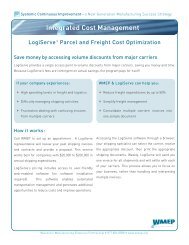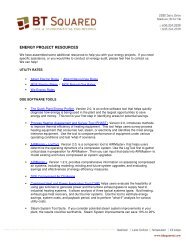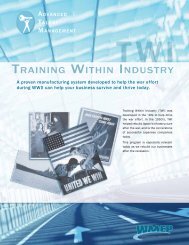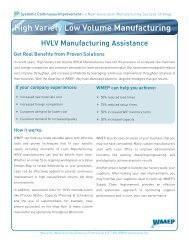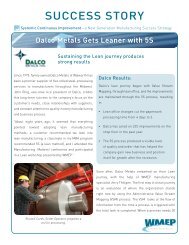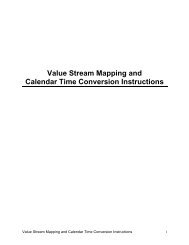Lean Culture - Wisconsin Manufacturing Extension Partnership
Lean Culture - Wisconsin Manufacturing Extension Partnership
Lean Culture - Wisconsin Manufacturing Extension Partnership
You also want an ePaper? Increase the reach of your titles
YUMPU automatically turns print PDFs into web optimized ePapers that Google loves.
L<br />
E<br />
A<br />
N<br />
E<br />
R<br />
Systemic Continuous Improvement—a Next Generation <strong>Manufacturing</strong> Success Strategy<br />
<strong>Lean</strong> <strong>Culture</strong><br />
<strong>Culture</strong> Matters: Why Top Management Must Take the Lead<br />
Old habits die hard. Companies can invest a lot of time<br />
and money in <strong>Lean</strong> efforts or other improvements, but<br />
if people eventually go back to their old ways, the gains<br />
won’t be sustained over time and improvement stalls.<br />
To truly transform into a <strong>Lean</strong> company, the company’s<br />
culture must be addressed. <strong>Culture</strong> isn’t a vague term<br />
– it is key for improvement success. Creating a <strong>Lean</strong><br />
<strong>Culture</strong> addresses both active resistance to change and<br />
the tendency of people, like a dieter reaching for ice<br />
cream, to revert back to old habits after the effort to<br />
change has passed.<br />
“<strong>Culture</strong> has really been missing over the years,” said<br />
Steve Straub, WMEP manufacturing specialist. During<br />
the 1980s, companies were implementing quality<br />
circles, TQM and other improvement efforts. “It was a<br />
lot of the same improvement changes companies are<br />
making now, but what was missing was getting people<br />
involved in the process.”<br />
<strong>Lean</strong> <strong>Culture</strong> deals with this issue by acknowledging<br />
that culture greatly influences many facets of daily work<br />
tasks, as well as improvement efforts. How change is<br />
introduced, and the reaction to it, is determined by<br />
culture.<br />
To better understand the dynamics of a <strong>Lean</strong> <strong>Culture</strong>,<br />
it helps to know what business culture is – a pattern<br />
of behaviors or problem-solving techniques commonly<br />
used by individuals in a company. A <strong>Lean</strong> <strong>Culture</strong><br />
has specific qualities that define the behavior of the<br />
employees.<br />
A <strong>Lean</strong> <strong>Culture</strong>:<br />
ff<br />
Focuses on the customer: “Employees need to<br />
understand who the customer is,” said Straub.<br />
“They have internal customers also. How they<br />
serve the external customer is directly tied to<br />
how they treat each other internally.”<br />
ff<br />
Is totally committed to continuous<br />
improvement: For this kind of commitment<br />
to occur, all employees must be involved in the<br />
improvement process. This means maintaining<br />
enthusiasm about the process and creating a safe<br />
environment for employees to make suggestions<br />
and take risks.<br />
ff<br />
Communicates a clear vision for the company<br />
to all employees: “This is key,” said Straub.<br />
“If everyone is going in a different direction or<br />
doesn’t understand the vision, it’s difficult to pull<br />
together as one big team.”<br />
ff<br />
Ensures everyone knows their roles by setting<br />
clear standards and expectations: The expected<br />
behaviors within the organization must be spelled<br />
out. It should be clear that the new culture is now<br />
customer-focused, and that the commitment<br />
to continuous improvement is genuine and<br />
permanent.<br />
<strong>Wisconsin</strong> <strong>Manufacturing</strong> <strong>Extension</strong> <strong>Partnership</strong> • 877.856.8588 • www.wmep.org
<strong>Lean</strong> <strong>Culture</strong><br />
A <strong>Lean</strong> <strong>Culture</strong> encourages all workers to contribute<br />
ideas, responds quickly to suggestions for<br />
improvement, works to keep everyone learning, seeks<br />
perfection in its products, services and processes,<br />
and enjoys the visible support of all leaders.<br />
Teams are Key<br />
Teams are the basis of the <strong>Lean</strong> <strong>Culture</strong> infrastructure<br />
and include a core team, steering team and project<br />
teams. Senior management makes up the core<br />
team, which works to support the <strong>Lean</strong> process<br />
and remove any roadblocks preventing successful<br />
implementation. The core team also provides metrics<br />
that are directly tied to the company’s success and<br />
that employees can directly affect. The steering<br />
team, a cross-functional, multi-level group, drives<br />
<strong>Lean</strong> implementation. Finally, project teams work on<br />
specific processes to improve efficiency.<br />
Even after establishing a <strong>Lean</strong> <strong>Culture</strong> infrastructure,<br />
some companies have problems sustaining change.<br />
Resistance often comes from middle managers who<br />
feel threatened because decision-making authority<br />
has been expanded. “Resistance can be overcome<br />
when they understand that their new role is to<br />
lead people, not manage them,” said Straub. “They<br />
should be focusing on strategic areas, not day-to-day<br />
decision making.” <strong>Lean</strong> Leadership addresses these<br />
issues.<br />
Management Support<br />
Changing a culture can’t be done without support<br />
from senior management. “If you don’t have buyin<br />
at the top, it won’t work,” said Straub. Senior<br />
managers are important because they set the ground<br />
rules for the new culture. In addition, long-term<br />
commitment to continuous improvement starts with<br />
top management. This commitment is expressed in<br />
policies, practices, language and actions that shape<br />
employee behavior at all levels. Because of the vital<br />
role played by top management, <strong>Lean</strong> Leadership is<br />
an essential part of <strong>Lean</strong> <strong>Culture</strong>.<br />
Training Leaders<br />
Since a primary goal of a <strong>Lean</strong> <strong>Culture</strong> is to build<br />
an empowered workforce, empowering leadership<br />
behaviors are crucial. Learning to use empowering<br />
leadership behaviors requires motivation and skill.<br />
Some actions senior leaders can take to create a<br />
<strong>Lean</strong> <strong>Culture</strong> include:<br />
ff<br />
Empowering workers at all levels to act on behalf<br />
of the customer. Assemble project teams made<br />
up of frontline workers and a steering team with<br />
rotating membership to foster the participation of<br />
all workers.<br />
ff<br />
Respecting and using the expertise of everyone.<br />
Put up a suggestion box that includes a formal<br />
system for implementing good suggestions.<br />
ff<br />
Encouraging risk-taking to test improvement ideas.<br />
Urge workers to try new ideas, such as changing<br />
the location of equipment to improve efficiency.<br />
The final decision on where it goes should be made<br />
by the people working in that area.<br />
ff<br />
Using <strong>Lean</strong> to improve the way people do their<br />
jobs, not to eliminate jobs. When you find extra<br />
capacity in one area of a process, there is usually<br />
another area where more capacity is needed. A
<strong>Lean</strong> <strong>Culture</strong><br />
Value Stream Map shows the locations of both<br />
bottlenecks and overcapacity. People can shift<br />
from one area to another.<br />
ff<br />
Building consensus on and establishing clear<br />
ground rules that support the vision. Get feedback<br />
from workers to make sure new rules are realistic.<br />
For example, can parts be supplied to assembly<br />
within a day? Find out before setting the rule in<br />
stone.<br />
ff<br />
Supporting continuous learning for everyone and<br />
actively seeking continuous learning for yourself.<br />
Set a specific goal (hrs/yr) for the amount of<br />
employee training.<br />
ff<br />
Making needed changes to align organizational<br />
structure, management systems and<br />
measurements with the vision. If you implement<br />
<strong>Lean</strong> on the shop floor, it will also be necessary<br />
to align the accounting system to <strong>Lean</strong>, i.e., <strong>Lean</strong><br />
Accounting, which uses different measures.<br />
Willingness to Learn<br />
Being an effective leader requires a willingness to<br />
learn new leadership strategies, including personal<br />
effectiveness and interpersonal effectiveness.<br />
Personal effectiveness helps people understand their<br />
own personality and recognize personality traits in<br />
others so that they can interact more effectively with<br />
them. Interpersonal effectiveness shows how to be<br />
a better communicator, actively listen and handle<br />
conflict resolution while preserving employees’ selfesteem<br />
such as collaborative strategies that help<br />
managers lead in a constructive, positive way.<br />
Leaders also are skilled at leading teams and<br />
managing change, especially when addressing the<br />
normal fear associated with change. “So many people<br />
have been put in a position of leadership, and they’ve<br />
not been given the tools to do it effectively,” said<br />
Straub. “When they find out about these strategies,<br />
they say, ‘Wow, I wish I’d known this before.’”<br />
The benefits of <strong>Lean</strong> <strong>Culture</strong> and <strong>Lean</strong> Leadership<br />
include retention of good employees, an improved<br />
bottom line and sustainable improvements. Without<br />
a <strong>Lean</strong> <strong>Culture</strong>, companies risk spending “hundreds<br />
of thousands of dollars on technical changes with<br />
no buy-in or ownership to sustain the change,” said<br />
Straub. “They realize short-term gains, but don’t get<br />
the long-term gains.” <strong>Lean</strong> <strong>Culture</strong> is not abstract but<br />
a real factor in generating long-term results, because<br />
changing the culture makes continuous improvement<br />
a way of life.<br />
About WMEP<br />
WMEP is a private, nonprofit consulting organization<br />
committed to the growth and success of <strong>Wisconsin</strong><br />
manufacturers. A leader in Next Generation<br />
<strong>Manufacturing</strong>, WMEP brings best practices to<br />
<strong>Wisconsin</strong> firms to help them achieve world-class<br />
performance through innovation and transformation.<br />
WMEP receives financial support from the <strong>Wisconsin</strong><br />
Department of Commerce, and partners with many<br />
public and private organizations to serve <strong>Wisconsin</strong><br />
manufacturers.<br />
If you want to learn more about <strong>Lean</strong>, call WMEP at 1.877.856.8588.<br />
<strong>Wisconsin</strong> <strong>Manufacturing</strong> <strong>Extension</strong> <strong>Partnership</strong> • 2601 Crossroads Drive, Suite 145 • Madison WI 53718-7923 • www.wmep.org



